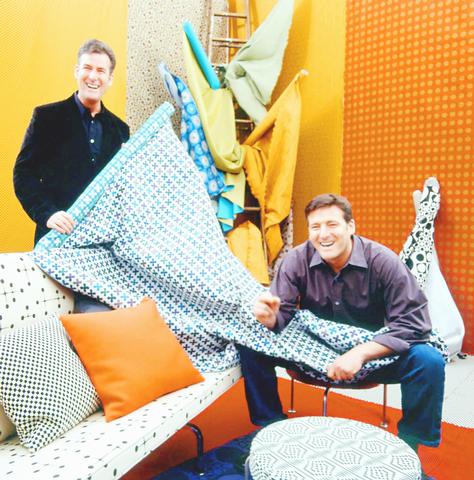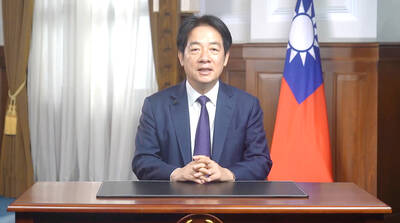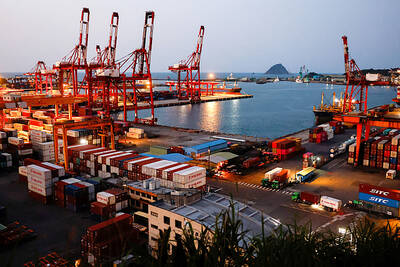While the plot thickeners are all in the mix -- two ambitious brothers, a multimillion-dollar family business that began with the proverbial pushcart, an indomitable father -- the Maharam story is no made-for-television melodrama.
But it is a tale about the warp and weave of the design-crazed '90s and about how those brothers managed to make office upholstery something to rave about -- and even to bring into the home.

PHOTO: NY TIMES
Maharam is a century-old textile company transformed over the last four years from a dowdy, mass-market operation known for fabrics sturdy enough to withstand a blowtorch into a company throwing off sparks. Last month the Cooper-Hewitt National Design Museum announced that Maharam is a finalist in its annual National Design Awards, which will be presented on Wednesday.
Having long outgrown its 1950s motto "House of Service," the Maharam name is now associated with some of the most progressive designs in the textile industry, including a rubberlike upholstery spun from the same mills used to make Prada's knapsacks and commissions to hot Dutch artists. Maharam has chalked up insider points as well by reintroducing patterns by design legends like Charles and Ray Eames, Alexander Girard, Verner Panton and Gio Ponti.
"They made a complete turnaround to become a real front-runner," said Jack Lenor Larsen, the modern textile designer and eminence grise of the industry, speaking of the Maharam brothers, Michael and Stephen, the fourth generation to run the company.
In an intensely competitive half-billion-dollar industry that sells contract textiles -- fabrics prized less for their looks than for their durability and flame resistance -- Maharam has played the panache card, and in the process, doubled profits to US$100 million over the last four years, said Stephen Maharam, at 39 the younger of the brothers.
"These are times when the difference between most designs is not the good versus the bad, but good versus great," said Michael Maharam, 42, the more outspoken of the brothers. Both are handsome in a wide-eyed Buzz Lightyear kind of way. "But there's too much splashy, flashy fluff out there," he added. "We're trying to do textiles that are clean, beautiful, perfect."
This swatch-world makeover began in the late 1960s with two brothers playing in the storage basement of an old Times Square warehouse. Their toys were Styrofoam balls, retractable extension rods and Mylar sheets, castoffs from their grandfather's garment-district business; he made stage curtains for theaters and panels for department store seasonal displays.
During their childhood, their father, Donald Maharam, had steered the company away from gold lame curtains to tap into a huge new market for hospital curtains, cubicle panel fabrics and grill cloths for RCA's first 10-inch color television cabinets. "It was not a company about creativity," Michael Maharam said. "It was about selling as many zillions of yards as possible."
The unglamorous held no appeal for Michael Maharam, who spent his 20s in self-discovery, working as, among other things, a maintenance man servicing celebrity aquariums in Beverly Hills. "Candy Spelling always wanted new fish brought in to match the color themes of her parties," he recalled of the movie mogul's wife. In San Francisco, he met Uschi Weismuller, a graphic designer from Switzerland, whom he married in 1997.
He returned briefly to Maharam in 1990, but left for travel abroad in protest of the hidebound managers who had assumed control of the company as his father phased himself into retirement.
All the while, Stephen Maharam worked steadfastly for the company, absorbing his father's strict sales technique. "First, nothing is ever `nice,"' he said. "My father always insisted that you search for better words, like gossamer or luxurious." After 12 years of rising at 5:30am and wining and dining clients five nights a week, a frustrated Stephen Maharam gave notice in 1997.
In response, Donald Maharam made a proposition to his sons: He'd buy out the company shares controlled by the two remaining partners and back the two boys if they would take command.
With no experience running anything like a company, much less one with 350 employees and 30 showrooms, the brothers did hesitate -- but not for long. "We were on a ski lift in Switzerland" Stephen Maharam recalled, "and we decided to give it a shot."
Michael would take over image, design, marketing; Stephen would run the show.
The timing couldn't have been better. By the mid-1990s, new design was the currency of the hip culture and the brothers began repositioning the company with a vengeance. Michael was forceful in demanding that the new Maharam have a fashion-inspired edge. No more sedated maroons and navy blue to muddy up the conference room. Maharam would sell the same palette that was cat-walking down the runways in Milan.
The first line under Michael Maharam's direction featured a full run of Gucci-compatible materials with a cling fit called Ready to Wear, about US$45 a yard. Another new line, Action Fabrics, US$35 a yard, is made of a duotone synthetic mesh textile in Nike-cool colors like lime on aqua, and orange on red. According to Mary Murphy, Maharam's director of design, they were the upholstery of choice for dot-com offices, where the work station was, for a while at least, the vocational equivalent of an extreme sport.
With their on-the-pulse designs -- and lofty press release references to the Cranbrook Academy of Art in Michigan and Hans Hoffman, the Abstract Expressionist -- Maharam made design savants tingle.
"I was never interested in contract textiles before I talked to Michael," said Murray Moss, who showcases Maharam's boldest bolts at his store, Moss, in SoHo. "They showed that contract doesn't have to be brown, washable and indestructible. What made it more interesting for me was that they also understand the link between fabric, pattern, graphics and furniture."
Michael Maharam, with his Yohji Yamamoto black shirt and vaudeville smile, is the public persona of Maharam. He likes to lunch. Even before the breadbasket arrives, he has run down his history of early rebellion, wanderlust and odd collecting habits (brass mouthpieces and Italian fishing lures). A favorite topic is his professional courtship of the daughters and widows of famous designers.
Lucia Eames, the daughter of Charles and Ray, invited him into her parents house to inspect their favorite colors in situ. On a visit to Milan, he met Lisa Ponti, daughter of Gio, who ripped off a strip of an original 70-year-old pattern (Lovers at the Window, US$120 to the trade) and handed it to him for reproduction.
While much of the credit for the Maharam revival belongs to the fabrics themselves, a tightly orchestrated image plays a part as well. In 1998, Michael Maharam's wife, Weismuller, took over the graphics, designing everything from fax cover sheets to construction showroom signage. The look has the clear simplicity of classic Modern, with a Scandinavian brightness. The Manhattan offices near Gramercy Park were redesigned by Fernlund & Logan, architects of the offices of the avant-garde journal Visionaire. Sample books in satellite showrooms are presented in color-coded cubic wall units a la Donald Judd.
"Employees were told to put away the beanie babies," Michael Maharam said, "and there would be no more handwritten labels."
Everything would be graphically clean, "even pharmaceutical," he added. Commissions went out to designer darlings, like Hella Jongerius, the Dutch designer, and Bruce Mau, the Canadian graphic artist. In addition to the archival reintroductions that endowed instant seriousness of purpose, Maharam is also developing a stringently monitored environmental line.
In keeping with the dictate that "nice" won't suffice, the Maharam sales force now attends monthly lectures by design cognoscenti like Aaron Betsky, a former curator at the San Francisco Museum of Modern Art. "I want the truck drivers in the warehouse to be able to talk about Gio Ponti," Michael Maharam said.
Competitors admire the way Maharam has inflated its image. "It's rare to find a company that has managed to inject the emotional and the inspirational into their project while still keeping an eye on efficiency and fulfillment," said Greg Parsons, the president of Herman Miller Red, a company that has collaborated with Maharam.
While figures are not available, the contract industry is beginning to slow down along with the rest of the economy. Maharam, Stephen Maharam says, is flush enough to undertake a complete overhaul of its Hauppauge, New York, warehouse.

US President Donald Trump yesterday announced sweeping "reciprocal tariffs" on US trading partners, including a 32 percent tax on goods from Taiwan that is set to take effect on Wednesday. At a Rose Garden event, Trump declared a 10 percent baseline tax on imports from all countries, with the White House saying it would take effect on Saturday. Countries with larger trade surpluses with the US would face higher duties beginning on Wednesday, including Taiwan (32 percent), China (34 percent), Japan (24 percent), South Korea (25 percent), Vietnam (46 percent) and Thailand (36 percent). Canada and Mexico, the two largest US trading

ACTION PLAN: Taiwan would expand procurement from the US and encourage more companies to invest in the US to deepen bilateral cooperation, Lai said The government would not impose reciprocal tariffs in retaliation against US levies, President William Lai (賴清德) said yesterday, as he announced five strategies to address the issue, including pledging to increase Taiwanese companies’ investments in the US. Lai has in the past few days met with administrative and national security officials, as well as representatives from various industries, to explore countermeasures after US President Donald Trump on Wednesday last week announced a 32 percent duty on Taiwanese imports. In a video released yesterday evening, Lai said that Taiwan would not retaliate against the US with higher tariffs and Taiwanese companies’ commitments to

‘SPECIAL CHANNEL’: Taipei’s most important tasks are to stabilize industries affected by Trump’s trade tariffs and keep negotiations with Washington open, a source said National Security Council Secretary-General Joseph Wu (吳釗燮) arrived in the US for talks with US President Donald Trump’s administration, a source familiar with the matter said on Friday. Wu was leading a delegation for a meeting known as the “special channel,” the Financial Times reported earlier. It marked Trump’s first use of the channel since returning to the White House on Jan. 20. Citing a source familiar with the matter, the Financial Times reported that Minister of Foreign Affairs Lin Chia-lung (林佳龍) was also a part of the delegation. The visit came days after China concluded war games around Taiwan and amid Trump’s

CHIP EXCEPTION: An official said that an exception for Taiwanese semiconductors would have a limited effect, as most are packaged in third nations before being sold The Executive Yuan yesterday decried US President Donald Trump’s 32 percent tariff on Taiwanese goods announced hours earlier as “unfair,” saying it would lodge a representation with Washington. The Cabinet in a statement described the pledged US tariffs, expected to take effect on Wednesday next week, as “deeply unreasonable” and “highly regrettable.” Cabinet spokeswoman Michelle Lee (李慧芝) said that the government would “lodge a solemn representation” with the US Trade Representative and continue negotiating with Washington to “ensure the interests of our nation and industries.” Trump at a news conference in Washington on Wednesday announced a 10 percent baseline tariff on most goods